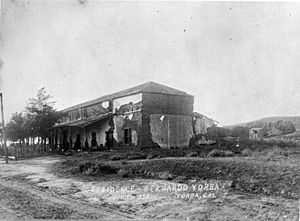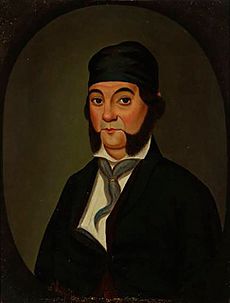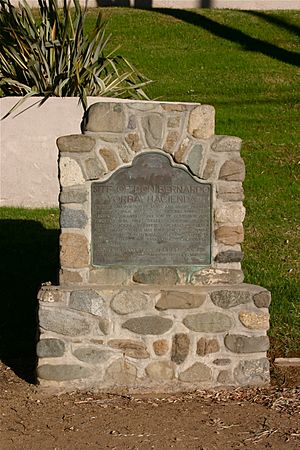Yorba Hacienda facts for kids
Quick facts for kids Yorba Hacienda |
|
|---|---|

Yorba Hacienda, 1926
|
|
| Location | Yorba Linda, California |
| Built | 1830s |
| Official name: Don Bernardo Yorba Hacienda | |
| Reference no. | 226 |
| Lua error in Module:Location_map at line 420: attempt to index field 'wikibase' (a nil value). | |
The Yorba Hacienda was a huge house built by Bernardo Yorba in the 1830s. It was located on his large ranch, Rancho Cañón de Santa Ana, in what is now Yorba Linda, California. This hacienda was the home of the richest person in the Yorba family. It was also the biggest adobe house in all of Alta California, which was the name for California when it was part of Mexico.
Contents
Building the Big House
On August 1, 1834, the Mexican Governor José Figueroa gave Bernardo Yorba a huge piece of land. It was about 13,328 acres (54 square kilometers) near the Santa Ana River.
How the Hacienda Was Built
In 1835, Bernardo Yorba started building his two-story adobe house. It became one of the biggest and best houses in all of Alta California. The construction happened in steps over several years. The main buildings were shaped like three sides of a square. Some say it had 200 rooms, but others say at least 50 rooms. The front of the main house was 106 feet long. Old photos show its roof was over 20 feet high.
Workers brought strong pine beams from the San Bernardino Mountains. These beams helped support the buildings. Native American servants made the adobe bricks used for building. They lived in their own camp closer to the river.
The Chapel and Cemetery
Around 1858, a small adobe chapel was built near the house. It was called Iglesia de San Antonio. It was officially opened on April 29, 1860. It was named after San Antonio, the special saint of the Yorba family. By the 1890s, the adobe chapel was old and worn out. So, a new wooden church was built nearby. This wooden church was no longer used by 1948 and was gone by 1956.
A family cemetery was also set up on a hill near the hacienda. Over 400 people were buried there until the 1930s. Bernardo Yorba and his second wife were buried there in 1923. This happened when another cemetery in Los Angeles closed. The last burials in the Yorba Cemetery were in 1939.
Life on the Ranch
The Yorba Hacienda was the main place for all activities in the area. It was also called Rancho San Antonio. In 1842, Governor Manuel Micheltorena stayed at the hacienda. He got supplies for his soldiers from the ranch. On January 6, 1847, General Stephen W. Kearny and Commodore Robert F. Stockton camped near the hacienda. A few days later, they won the Battle of Río San Gabriel near Los Angeles. This battle helped America take control of southern California. It also ended Mexican rule in California.
The hacienda was far from the nearest town, Los Angeles. So, Bernardo Yorba made sure many different jobs could be done right there. There were people who worked with wool, leather, and soap. There was also a person who made butter and cheese from 50 to 60 cows. Other workers included a harness maker, shoemakers, a jeweler, and a plasterer. There was also a carpenter and a blacksmith.
The ranch also had errand boys, a sheepherder, a cook, and a baker. There were two washer women, one ironer, four sewing women, and a dressmaker. Two gardeners, a schoolmaster, and winemakers also worked there. They made wines like Angelica and Port. They also made whiskey and brandy. Special foods like dates, dried fruits, and candy were brought from San Francisco. These were also shared with other ranches nearby. About 100 Gabrieleño Indians worked for Bernardo Yorba on the ranch. They lived in a village close by.
Bernardo Yorba was also like a local judge, called an alcalde. He needed a place to keep people who broke the law. A jail was located between the main house and the schoolrooms. There was a dark cellar underground called the 'dungeon' where criminals were locked up.
After Bernardo Yorba died in 1858, the Native American servants left. The hacienda slowly began to decline. The land was divided among Bernardo's children.
What Happened to the Hacienda
In 1917 and 1919, two local students, Don Meadows and Roch Bradshaw, visited the ruins. They measured, photographed, and studied the site. Don Meadows later wrote a short story about their visit.
The Yorba family and the county leaders could not agree on how much land to save for the hacienda. In 1926, the owner, Samuel Kraemer, tore down the building. He wanted to stop people from damaging it more. He then plowed the land to plant a new barley field. All the adobe ruins and trees were torn down. They were dumped into a nearby ditch called a barranca. The Yorba cemetery closed in 1939. After that, people damaged or stole many of the grave markers.
Present Day
The place where the hacienda stood is now a California Historical Landmark. It is number 226. A stone marker was placed there on May 3, 1950. It has a bronze plaque that tells a short history of the site. The marker is on the northeast corner of Esperanza Road and Echo Hill Lane in Yorba Linda.
The plaque says that the base of the marker has some original adobe bricks. These bricks were supposedly saved from the ditch where the ruins were dumped. You can see a few red bricks on the back. But most of the base is made of large stones cemented together. The marker is actually about 55 yards northeast of where the main house used to be. The real spot of the house is now under the westbound fast lane of Esperanza Road.
The Yorba Cemetery is the only part of the Yorba Hacienda that still exists. It is now surrounded by Woodgate Park and Woodgate Condominium Association. The cemetery was given to Orange County in 1967. Today, the county parks department takes care of it. Work is being done to restore it, and tours are available.




